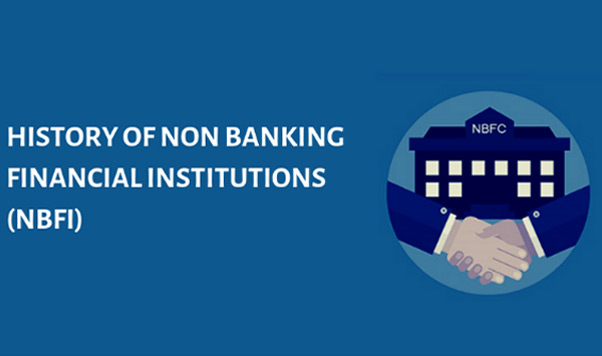History of Non-Banking Financial Institutions (NBFI)
Updated On : August 2019
Non-Banking Financial Companies are rising fast as an integral part of the Indian financial system. A non-banking financial institution (NBFI) or non-bank financial company (NBFC) does not have a full banking license but facilitate bank-related financial services like investment, contractual savings, and market brokering and risk pooling. They play a big role in strengthening the economy and have been able to carve out a place for themselves in meeting the credit needs of both wholesale and retail customers.
Role of NBFI in the financial system
- NBFIs act as a supplement to banks by providing infrastructure to distribute excess resources to individuals and companies with deficits.
- NBFIs also serve the additional purpose of introducing competition in financial services.
- Unlike banks who may offer a packaged deal on a set of financial services, NBFIs offer customized services to suit the specific needs of clients NBFIs specializing in one particular sector develop an informational advantage.
- From loans and credit facilities to private education funding and retirement planning, from trading in money markets to underwriting stocks and shares, and Term Finance Certificates, NBFCs offer almost all banking services. They provide wealth management services like managing stocks and shares portfolios, discounting services like discounting of instruments and give advice on merger and acquisition activities.
- The number of NBFCs has increased greatly in the last several years due to venture capital companies, retail and industrial companies have entered the lending business. NBFCs also often support property investments in property besides preparing feasibility, market or industry studies for companies.
- NBFCs are usually not allowed to take deposits from the general public and have to find options for funding their operations.
- NBFCs do not provide cheque books nor do they provide a saving account and current account. They are only authorized to takes fixed deposit or time deposits.
Some of the key regulations for acceptance of deposits by the NBFCs are
- They are allowed to accept or renew public deposits for a minimum period of 12 months and a maximum period of 60 months.
- They cannot accept deposits repayable on demand.
- They cannot offer interest rates higher than the ceiling rate prescribed by RBI from time to time.
- They cannot offer gifts/incentives or any other additional benefit to the depositors.
- They should have the minimum investment grade credit rating
- Their deposits are not insured.
- RBI does not guarantee the repayment of deposits by NBFCs.
A brief history of NFBI
- NBFCs started humbly in India in the 1960s as an alternative for savers and investors whose financial needs were not sufficiently met by the existing banking system. The NBFCs initially operated on a limited scale without making much impact on the financial industry. They invited fixed deposits from investors and worked out leasing deals for big industrial firms.
- In the first stages of development, the Companies Act regulated financing. However, the unique and complex nature of operations and with financial companies acting as financial intermediaries, there was a call for a separate regulatory mechanism.
- Hence, Chapter III B was included in the Reserve Bank of India Act, 1934, which assigned the Bank with limited authorities to regulate deposit-taking companies. Since then the RBI has initiated measures to regulate the NBFC sector.
- The RBI accepted and implemented that hire purchase and leasing companies could accept deposits to the extent of their net owned funds, as per the key recommendations of James S. Raj Study Group formed in 1975. The Companies were also required to maintain liquid assets in the form of unencumbered approved government securities.
- Between the 1980s and 1990s, NBFCs, with their customer-friendly reputation, began to attract a huge number of investors. The number of NBFCs rose swiftly from a mere 7000 in 1981 to around 30000 in 1992, which made the RBI feel the need to regulate the industry. In 1992, the RBI formed a Committee headed by the former Chairman of Bank of Baroda, Mr. A. C. Shah, to suggest measures for effective regulation of the industry. The Shah Committee's recommendations included most things from compulsory registration to prudential norms.
- In January 1997 there were huge changes in the RBI Act, 1934, especially the Chapters III-B, III-C, and V of the Act seeking to put in place a complete regulatory and supervisory structure, which would protect the interests and also ensure the smooth functioning of NBFCs.
- After the amendment of the Act in 1997, the NBFCs have grown significantly in terms of operations, range of instruments and market products, technological advancement, among others.
- In the last 20 years, the NBFCs have gained prominence and added depth to the financial sector. In August 2016, the union cabinet gave the go-ahead for foreign direct investment (FDI) under the automatic route in regulated NBFCs.
Leave Comments :
Latest Blog
-
 Driving Rural Financial Inclusion with Lending Management Software Updated
On : June 2025
Driving Rural Financial Inclusion with Lending Management Software Updated
On : June 2025
-
 The Rise of AI in Credit Risk and Lending Software Updated
On : July 2025
The Rise of AI in Credit Risk and Lending Software Updated
On : July 2025
-
 Green Lending: ESG Metrics Embedded in Lending Software Updated
On : July 2025
Green Lending: ESG Metrics Embedded in Lending Software Updated
On : July 2025
-
 The Role of Blockchain in Modern Lending Management Software Updated
On : July 2025
The Role of Blockchain in Modern Lending Management Software Updated
On : July 2025
-
 Ensuring Compliance in Loan Origination Software Updated
On : June 2025
Ensuring Compliance in Loan Origination Software Updated
On : June 2025



Comments :